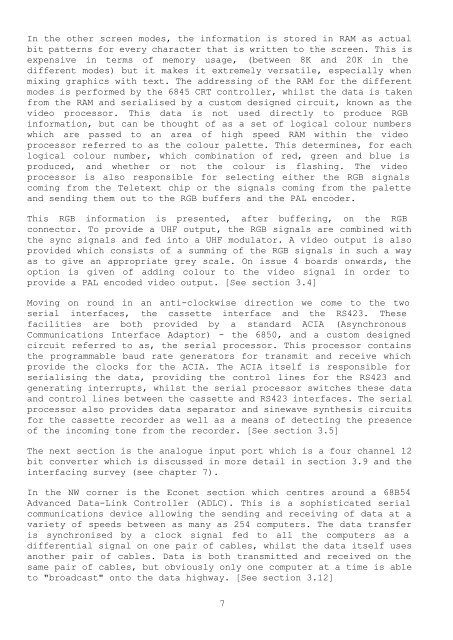BBC Microcomputer Service Manual Oct 1985 Section 1 BBC Micro ...
BBC Microcomputer Service Manual Oct 1985 Section 1 BBC Micro ...
BBC Microcomputer Service Manual Oct 1985 Section 1 BBC Micro ...
You also want an ePaper? Increase the reach of your titles
YUMPU automatically turns print PDFs into web optimized ePapers that Google loves.
In the other screen modes, the information is stored in RAM as actual<br />
bit patterns for every character that is written to the screen. This is<br />
expensive in terms of memory usage, (between 8K and 20K in the<br />
different modes) but it makes it extremely versatile, especially when<br />
mixing graphics with text. The addressing of the RAM for the different<br />
modes is performed by the 6845 CRT controller, whilst the data is taken<br />
from the RAM and serialised by a custom designed circuit, known as the<br />
video processor. This data is not used directly to produce RGB<br />
information, but can be thought of as a set of logical colour numbers<br />
which are passed to an area of high speed RAM within the video<br />
processor referred to as the colour palette. This determines, for each<br />
logical colour number, which combination of red, green and blue is<br />
produced, and whether or not the colour is flashing. The video<br />
processor is also responsible for selecting either the RGB signals<br />
coming from the Teletext chip or the signals coming from the palette<br />
and sending them out to the RGB buffers and the PAL encoder.<br />
This RGB information is presented, after buffering, on the RGB<br />
connector. To provide a UHF output, the RGB signals are combined with<br />
the sync signals and fed into a UHF modulator. A video output is also<br />
provided which consists of a summing of the RGB signals in such a way<br />
as to give an appropriate grey scale. On issue 4 boards onwards, the<br />
option is given of adding colour to the video signal in order to<br />
provide a PAL encoded video output. [See section 3.4]<br />
Moving on round in an anti-clockwise direction we come to the two<br />
serial interfaces, the cassette interface and the RS423. These<br />
facilities are both provided by a standard ACIA (Asynchronous<br />
Communications Interface Adaptor) - the 6850, and a custom designed<br />
circuit referred to as, the serial processor. This processor contains<br />
the programmable baud rate generators for transmit and receive which<br />
provide the clocks for the ACIA. The ACIA itself is responsible for<br />
serialising the data, providing the control lines for the RS423 and<br />
generating interrupts, whilst the serial processor switches these data<br />
and control lines between the cassette and RS423 interfaces. The serial<br />
processor also provides data separator and sinewave synthesis circuits<br />
for the cassette recorder as well as a means of detecting the presence<br />
of the incoming tone from the recorder. [See section 3.5]<br />
The next section is the analogue input port which is a four channel 12<br />
bit converter which is discussed in more detail in section 3.9 and the<br />
interfacing survey (see chapter 7).<br />
In the NW corner is the Econet section which centres around a 68B54<br />
Advanced Data-Link Controller (ADLC). This is a sophisticated serial<br />
communications device allowing the sending and receiving of data at a<br />
variety of speeds between as many as 254 computers. The data transfer<br />
is synchronised by a clock signal fed to all the computers as a<br />
differential signal on one pair of cables, whilst the data itself uses<br />
another pair of cables. Data is both transmitted and received on the<br />
same pair of cables, but obviously only one computer at a time is able<br />
to "broadcast" onto the data highway. [See section 3.12]<br />
7

















